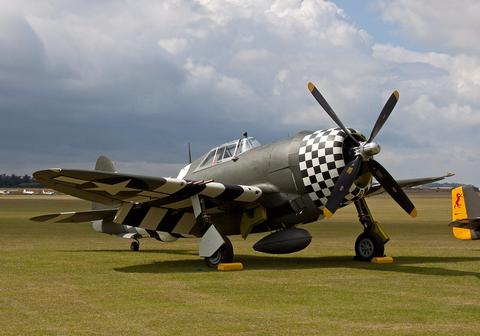
- by Dave Hall
P-47 Thunderbolt: A Juggernaut Over German Skies
- by Dave Hall
A question? Visit our contact page
This site uses cookies for better user experience and analytics.

The P-47 G Thunderbolt was one of the most successful American fighters of WWII. The Thunderbolt, also known as the Juggernaut, or the Jug, escorted relentless bombing runs over Germany, battling interceptors to protect Allied bombers. Get your own P-47 G Thunderbolt PlaneTags.

The P-47, manufactured from 1941 to 1945, was a United States World War II fighter. It was the largest, heaviest, and most expensive single piston engine fighter in history. It was effective as a short-to-medium range escort fighter aircraft, as well as a low altitude fighter-bomber. It served in nearly every war theater as a part of several Allied armies. It became one of the United States Army Air Force’s main fighters during the war. It was regarded for its sturdy construction, ruggedness, and ability to suffer severe battle damage and make it home. Its roomy, armored cockpit and bubble canopy provided excellent visibility, making it a pilot favorite. Ultimately, 15,660 Thunderbolts were produced before the war’s end.

Curtiss P-47G-10-CU "Thunderbolt" / Republic P-47D-5 built under license by Curtiss-Wright Aircraft, Buffalo, New York. Designated P-47G (sn 42-25068) flickr photo by aeroman3 shared with no copyright restrictions using Creative Commons Public Domain Mark (PDM)

B-17 and P-47 - Flying Legends 2013 flickr photo by Hawkeye UK shared under a Creative Commons (BY-SA) license
They were built by Republic Aviation. The demand became so great that Republic built a second plant in Evansville, Indiana to produce the P-47D. Ultimately, Curtiss built 354 of the P-47G variant, which were identical to the Republic version and were mostly used stateside for training.
A closer look at the P-47 G:

P-47G-10 Thunderbolt 42-25068 flickr photo by ahisgett shared under a Creative Commons (BY) license
Our P-47, serial number 42-25068, tail # N47FG began its long and exciting life when it was accepted by the USAAF in September 1943 and sent to Florida to be used for Air Force training. In June 1945, released from its wartime duties, it was then bought by Aero Industries Technical Institute in Oakland, CA where it was used to teach hydraulic and electrical systems until 1952.
In 1953, it was then rented out by its owner Jack Hardwick for a film called Fighter Attack, by Allied Artists, as well as used as a ground engine test rig. It remained parked in El Monte, California until 1975.
After that, it changed registration several times, to N42354, N47DG and 28476, during which time the plane was fully restored and took flight again in April 1982. The next leg of its journey brought it to the UK, where it remained in storage until 2006. It belonged to The Fighter Collection in Duxford, UK through 2013, then joined the Comanche Warbirds, Inc. in 2014. It was seen in the film The Monuments Men, playing the part of P-47D/42-74742 SNAFU. It remains an airworthy example of wartime ingenuity.
When MotoArt owner Dave Hall found out that there was original skin available from a fighter with such an interesting history he knew he needed it for the PlaneTags collection. “It came from the restoration and there wasn’t a lot of material to work with but I was glad to get what I could.”
The team was able to make a very small run of PlaneTags. “Sometimes we’re asked if it's worth it to go through all of what we do to release a new one for such a limited run, “ said Hall. “Absolutely! This is an incredible plane and we know that our customers will appreciate being able to add it to their collections. We are so pleased to add it to our Encyclopedia of Aircraft.”

The newest additions to the fleet come mostly in military green, though there are a few color variations. They are numbered to 280 and come attached to a colorful display card with a brief history. They make a perfect Father’s Day present or pilot gift.
Ten Awesome Aviation Gifts Your AVGeek Dad Will Love
SR-71 Blackbird News: 2 Days Until New SR-71 PlaneTags Release
SR-71 PlaneTags: How MotoArt Preserved a Piece of Blackbird History
The SR-71 Blackbird is one of the most iconic aircraft ever built, known for its unparalleled speed, high-altitude capabilities, and groundbreaking design. Developed by Lockheed’s Skunk Works during the Cold War, the SR-71 was designed to be the fastest and highest-flying reconnaissance aircraft in history. With speeds reaching Mach 3.35 (2,200 mph) and cruising altitudes exceeding 85,000 feet, it set records that have yet to be broken.
Now, you can own a piece of this aviation legend. MotoArt has meticulously crafted exclusive SR-71 PlaneTags from the actual parts of the aircraft, allowing aviation enthusiasts and collectors to hold a piece of history in their hands. These PlaneTags offer a unique opportunity to connect with the SR-71 in a way that was never before possible.
The SR-71 Blackbird: A Legacy of Speed and Innovation
For aviation enthusiasts and collectors, the SR-71’s legacy continues to captivate. Now, you have the opportunity to own a piece of this legendary aircraft through SR-71 PlaneTags, crafted from the very materials that made this remarkable plane a star of the skies. But before we dive into the story of these unique collectibles, let’s take a look back at the SR-71’s incredible journey and its lasting impact on the world of aviation. Sign up for exclusive access today.


Share:
MotoArt’s Military Planes: Saluting Our Mighty Defenders
Lucky Lady III: A Record Setting B-52